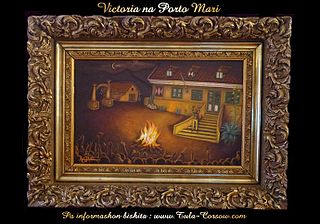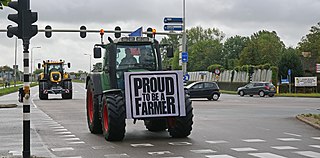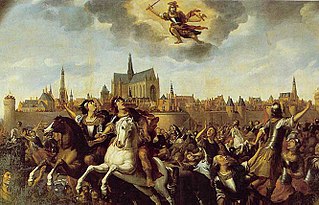
Hoogeveen is a municipality and a town in the Dutch province of Drenthe.

The Eighty Years' War or Dutch Revolt was an armed conflict in the Habsburg Netherlands between disparate groups of rebels and the Spanish government. The causes of the war included the Reformation, centralisation, excessive taxation, and the rights and privileges of the Dutch nobility and cities.

The Georgian uprising on Texel was an insurrection by the 882nd Infantry Battalion Königin Tamara of the Georgian Legion of the German Army stationed on the German-occupied Dutch island of Texel. The battalion was made up of 800 Georgians and 400 Germans, with mainly German officers. It was one of the last battles in the European theater.

The Flemish peasant revolt of 1323–1328, sometimes referred to as the Flemish Coast uprising in historical writing, was a popular revolt in late medieval Europe. Beginning as a series of scattered rural riots in late 1323, peasant insurrection escalated into a full-scale rebellion that dominated public affairs in Flanders for nearly five years until 1328. The uprising in Flanders was caused by excessive taxations levied by the Count of Flanders Louis I and by his pro-French policies. The insurrection had urban leaders and rural factions, which took over most of Flanders by 1325.

Hollandscheveld is a village in the municipality of Hoogeveen, the Netherlands. It was founded in the 17th century after the Hollandsche Compagnie bought the land to harvest its peat. It was initially named Hollandsche Veld which was later combined into just Hollandscheveld.

The Spanish Fury was a number of violent sackings of cities (lootings) in the Low Countries or Benelux, mostly by Spanish Habsburg armies, that happened in the years 1572–1579 during the Dutch Revolt. In some cases, the sack did not follow the taking of a city. In others, the sack was ordered, or at least not restrained, by Spanish commanders after the fall of a city.

The Capture of Brielle by the Watergeuzen, on 1 April 1572 marked a turning point in the uprising of the Low Countries against Spain in the Eighty Years' War. Militarily the success was minor as the port of Brielle was undefended, but it provided the first foothold on land for the rebels at a time when the rebellion was all but crushed, and it offered the sign for a new revolt throughout the Netherlands which led to the formation of the Dutch Republic.
The Farmers' Party was a Dutch agrarian political party, with a strong conservative outlook and a populist appeal. The BP was the first anti-establishment party elected into the Dutch House of Representatives after the Second World War.
The Cazin rebellion was an armed anti-state rebellion of peasants that occurred in May 1950 in the towns of Cazin and Velika Kladuša in the Bosanska Krajina region, as well as Slunj in Croatia, at that time part of Communist Yugoslavia. The peasants revolted against the forced collectivization and collective farms set up by the Yugoslav government following a drought in 1949, after which they had been punished due to their inability to meet the quotas. The ringleaders were persecuted and some killed, including many innocent civilians.

The Curaçao Slave Revolt of 1795 was a slave revolt in the Dutch colony of Curaçao, led by the enslaved man Tula. It resulted in a month-long conflict on the island between escapees and the colonial government. Tula was aware of the Haitian Revolution that had resulted in freedom for the enslaved in Haiti. He argued that, since the European Netherlands was now under French occupation as a sister republic, the slaves on Curaçao should get their freedom as well.

The siege of Valenciennes took place between 14 December 1566 and 23 March 1567 at Valenciennes, then in the Spanish Netherlands. It is sometimes considered the first siege of the Eighty Years' War. Following the Beeldenstorm, which reached the city on 24 August 1566, Calvinists under the leadership of Pérégrin de La Grange and Guido de Brès fortified themselves within Valenciennes' walls. The acting stadtholder of Hainaut, Philip of Noircarmes, subdued the city after months of failed negotiations, starvation, and finally an artillery bombardment.

The Dutch farmers' protests are a series of demonstrations by Dutch livestock farmers, characterised by the use of tractors to block roads, and occupy public spaces. The protests were initially triggered in October 2019 by a proposal in parliament to halve the country's livestock in an attempt to limit agricultural pollution in the Netherlands, but protesting farmers have frequently told media that they are motivated by a perceived lack of respect for their profession by the Dutch populace, media and politicians. The protests combined several action groups and an amalgamation of larger goals, which included less government regulation for farmers, more air time for pro-farmer sentiments, and more policy to punish Shell and Tata Steel for their part in the emission crisis.
The aftermath of the Eighty Years' War had far-reaching military, political, socio-economic, religious, and cultural effects on the Low Countries, the Spanish Empire, the Holy Roman Empire, as well as other regions of Europe and European colonies overseas. By the Peace of Münster, the Habsburg Netherlands were split in two, with the northern Protestant-dominated Netherlands becoming the Dutch Republic, independent of the Spanish and Holy Roman Empires, while the southern Catholic-dominated Spanish Netherlands remained under Spanish Habsburg sovereignty. Whereas the Spanish Empire and the Southern Netherlands along with it were financially and demographically ruined, declining politically and economically, the Dutch Republic became a global commercial power and achieved a high level of prosperity for its upper and middle classes known as the Dutch Golden Age, despite continued great socio-economic, geographic and religious inequalities and problems, as well as internal and external political, military and religious conflicts.
The historiography of the Eighty Years' War examines how the Eighty Years' War has been viewed or interpreted throughout the centuries. Some of the main issues of contention between scholars include the name of the war, the periodisation of the war, the origins or causes of the war and thus its nature, the meaning of its historical documents such as the Act of Abjuration, and the role of its central characters such as Philip II of Spain, William "the Silent" of Orange, Margaret of Parma, the Duke of Alba, the Duke of Parma, Maurice of Orange, and Johan van Oldenbarnevelt. It has been theorised that Protestant Reformation propaganda has given rise to the Spanish Black Legend in order to portray the actions of the Spanish Empire, the Army of Flanders and the Catholic Church in an exaggerated extremely negative light, while other scholars maintain that the atrocities committed by the Spanish military in order to preserve the Habsburg Netherlands for the Empire have historically been portrayed fairly accurately. Controversy also rages about the importance of the war for the emergence of the Dutch Republic as the predecessor of the current Kingdom of the Netherlands and the role of the House of Orange's stadtholders in it, as well as the development of Dutch and Belgian national identities as a result of the split of the Northern and Southern Netherlands.

The period between the start of the Beeldenstorm in August 1566 until early 1572 contained the first events of a series that would later be known as the Eighty Years' War between the Spanish Empire and disparate groups of rebels in the Habsburg Netherlands. Some of the first pitched battles and sieges between radical Calvinists and Habsburg governmental forces took place in the years 1566–1567, followed by the arrival and government takeover by Fernando Álvarez de Toledo, 3rd Duke of Alba with an army of 10,000 Spanish and Italian soldiers. Next, an ill-fated invasion by the most powerful nobleman of the Low Countries, the exiled but still-Catholic William "the Silent" of Orange, failed to inspire a general anti-government revolt. Although the war seemed over before it got underway, in the years 1569–1571, Alba's repression grew severe, and opposition against his regime mounted to new heights and became susceptible to rebellion.
The origins of the Eighty Years' War are complicated, and have been a source of disputes amongst historians for centuries.

The Kennemer uprising was a rebellion of farmers in the County of Holland and Prince-Bishopric of Utrecht in the Holy Roman Empire, that took place between 1272 and 1274. The commoners or huislieden from the Kennemerland, a bailiwick within the County of Holland, rose up against their bailiff and the other nobles. The movement spread to the nearby West Friesland, Waterland and Amstelland. The lord of Amstelland, Gijsbrecht IV of Amstel decided to join the insurrenction and became the leader of the Kennemers. Later Utrecht, Amersfoort and Eemland also joined. Eventually, the Kennemers were defeated.

The 1989–1990 Dutch farmers' protests, for want of an unambiguous official name also referred to as the Farmers' Revolt, was a series of protests by Dutch farmers of arable land. Starting locally in February–March 1989 and culminating in nationwide demonstrations in February–March 1990, the protests were a response to changes in government agricultural policy beginning in the mid-1980s.

The 1971 Dutch farmers' revolt took place on 21 December 1971 in the municipality of Tubbergen in Overijssel, the Netherlands. The rebellion was set off by an intended land consolidation of, in particular, agricultural land.














